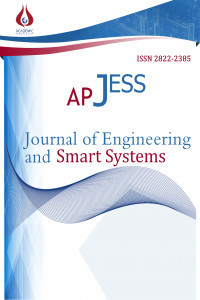Şev Stabilitesi Probleminin Geri Analizle Çözümü: Örnek Bir Vaka
Şev stabilitesi, Vaka analizi, Geri analiz, Ağırlık yüklemesi
Slope stability, Case study, Back analysis, Gravity loading,
___
- [1]. NBCNews,URL:http://www.nbcnews.com/id/36782187/ns/weather/t/landslide-buries-cars-cuts-highway-taiwan/#.XpQyLTdR2Ul (Erişim zamanı: Nisan, 26, 2010)
- [2]. BBC News URL: https://www.bbc.com/turkce/haberler-dunya-40391372 (Erişim zamanı; Haziran, 24, 2017).
- [3]. K. Öztürk, “Heyelanlar ve Türkiyeye Etkileri”, Gazi Üniversitesi, Gazi Eğitim Fakültesi Dergisi, 22(2), 2002.
- [4]. O. A. M. Moudabel, “Slope Stability Case Study By Limit Equilibrium and Numerical Methods”, Doctoral dissertation, Oklahoma State University, Libya, 2013.
- [5]. T. Taşkıran, V. S. Yavuz, ve M. S. Keskin, “Şev stabilitesinin iki ve üç boyutlu modeller ile incelenmesi”, DÜMF Mühendislik Dergisi, 6(1): 1-8, 2015.
- [6]. F. Tschuchnigg, , H. F. Schweiger, S. W. Sloan, A. V. Lyamin, and I. Raissakis, “Comparison of finite-element limit analysis and strength reduction techniques”. Géotechnique, 65(4): 249-257, 2015.
- [7]. M. Neves, V. Cavaleiro, and A. Pinto, “Slope Stability Assessment and Evaluation of Remedial Measures Using Limit Equilibrium and Finite Element Approaches,” Procedia Engineering, vol. 143, no. Ictg, pp. 717–725, 2016.
- [8]. E. Bol, S. Sert, and A. Özocak, “Kazıklı iksa sistemi ile şev duraylılığının sağlanması Ensuring slope stability with piled retaining system,” vol. 21, no. 5, pp. 860–870, 2017.
- [9]. M. Pirone and G. Urciuoli, “Computers and Geotechnics Analysis of slope-stabilising piles with the shear strength reduction technique,” Computers and Geotechnics, vol. 102, no. June, pp. 238–251, 2018.
- [10]. G. Chen, C. Li, and Q. Fang, “Slope Stabilization Using Back-analysis Method,” In IOP Conference Series: Earth and Environmental Science, vol. 332, no. 2, p. 022058, IOP Publishing, 2019.
- [11]. Büyükkağnıcı, C. Z., ve Işık, N. S., "Şev Duraylılığı Analizlerinde Limit Denge Yöntemleri, Eurocode 7 Ve Bs 8006 Standartlarıyla Hesaplanan Başarı Oranlarının Karşılaştırılması", TÜBAV Bilim Dergisi, 12(2), 18-29, 2019.
- [12]. Alemdağ, S., "Toprak Dolgulu Barajlarda Gövde Duraylılığının Limit Denge Ve Sayısal Analiz Yöntemleri İle Değerlendirilmesi: Türkiye’den Bir Atık Barajı Örneği", Gümüşhane Üniversitesi, Fen Bilimleri Enstitüsü Dergisi, 6(2), 157-173, 2016.
- [13]. Huvaj, N., and Oğuz, E. A., "Probabilistic slope stability analysis: a case study", Sakarya Üniversitesi, Fen Bilimleri Enstitüsü Dergisi, 22(5), 1458-1465, 2018.
- [14]. Göktepe, F., and Keskin, I., "A comparison study between traditional and finite element methods for slope stability evaluations", Journal of the Geological Society of India, 91(3), 373-379, 2018.
- [15]. Onur, M. I., Tuncan, M., Evirgen, B., Ozdemir, B., and Tuncan, A., "Behavior of soil reinforcements in slopes. Procedia engineering", 143, 483-489, 2016.
- [16]. J. M.,Duncan, S. G. Wright, , and T. L. Brandon, "Soil strength and slope stability", Canada, John Wiley and Sons, 2014.
- [17]. R. Ulusay, "Şevlerin Duraylılığı ve Tasarımı. Kurs Notu", Hacettepe Üniversitesi, Ankara, (yayınlanmamış) 2002.
- [18]. Plaxis Reference Manual (Edited by: R.B.J. Brinkgreve, S. Kumarswamy, W. M. Swolfs., F. Foria), Netherlands, Delft University of Technology and Plaxis b.v., 2018.
- [19]. T. L. Gouw., “Common Mistakes on the Application of Plaxis 2D in Analyzing Excavation Problems”, International Journal of Applied Engineering Research, 9(21), pp 8291-8311, 2014.
- [20]. Plaxis Material Models Manual, Reference Manual. (Edited by R.B.J.Brinkgreve), Netherlands, Delft University of Technology and Plaxis b.v., 2002.
- Yayın Aralığı: Yılda 3 Sayı
- Başlangıç: 2022
- Yayıncı: Akademik Perspektif Derneği
Fotometrik Flicker Olayının İnsana Etkileri ve Bunların Tıbbi Olmayan Tespit Yöntemleri
Cenk YAVUZ, Ceyda AKSOY TIRMIKÇI
Hilmi Evren ERDİN, M. Burcu SILAYDIN AYDIN, Nur Sinem PARTİGÖÇ, Hayat ZENGİN ÇELİK, Arzu PALAZCA, Çiğdem HOROZ
An Expert System to Predict Eye Disorder Using Deep Convolutional Neural Network
Moahmmed Rashid AHMED, Saadaldeen Rashid AHMED, Adil Deniz DURU, Osman Nuri UÇAN, Oğuz BAYAT
İstanbul Boğazı’nda Transit Geçiş Yapan Gemilerin Egzoz Gazı Emisyonlarının İncelenmesi
Ortoper Bulanık Kümelerle Bir Karar Verme Yaklaşımı: Ortoper Bulanık TOPSIS Metodu
Çarpık Dağılımlar için Çarpıklık Düzeltmesi Yöntemine Dayalı X ve R Kontrol Grafikleri
Sevgi YURT ÖNCEL, Handan ÖZARSLAN
Esra GENCELİ, Gülsüm ÜRPER, Reyhan ŞENGÜR, Türker TÜRKEN, İsmail KOYUNCU
